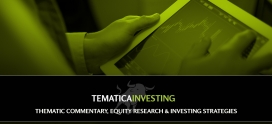Boom or Gloom? What’s in Your Wallet?
We keep hearing about how the economy is accelerating, yet many are still struggling to make ends meet as our Cash-Strapped Consumer investing theme remains strong. Just yesterday President Trump told reporters that he believes it is possible for the economy to reach 6% annual GDP growth rate, which would be 2.6 times the average rate of growth over the past four quarters. Global GDP growth looks to be around 3.7% this year and is forecasted to grow between 3.8% and 4.0% in 2018. That all sounds great but…
As we mentioned earlier this week, we continue to see consumers under duress, a real anomaly at this stage of the business cycle and particularly odd when unemployment is at a 17-year low of 4.1% versus the 10% we experienced at the peak of the crisis. So what is happening?
Annual wage growth in the U.S. has averaged 2.2% since the crisis and has never been more than 3%, while the pre-crisis average was well over 3%. Ouch. According to a recent Bankrate.com study, over the past 12 months, 52% of American employees did not have any increase in wages either through a pay raise or through a new job. For workers aged 53 and older, 64% received no increase. No wonder there is so much frustration!
Those in the U.S.
The chart below shows how changes in real compensation have been much weaker since the crisis than has been the historical norm and has been declining for the past four quarters.
The wage share of national income remains at near record lows and has been falling for decades.
As Americans have struggled through the weakest income growth in over a half century, 57% have less than $1,000 in their savings account and 39% have no savings at all. 76% of Americans are concerned about their ability to achieve a secure retirement, according to the National Institute of Retirement Security. Nearly 40 million working-age households (45%) have no retirement assets. Across all households, the median retirement account balance is $2,500 for all working-age households and $14,500 for near-retirement households.
I’d also like to point out that people tend to respond to incentives. When it comes to anything leftover in the wallet after paying for all the necessities, the trade-off is between spending today (new shoes!) or saving it and having more in the future. As interest rates fall, the benefit of savings declines, making the benefit of holding off today for more tomorrow less attractive. The chart below can attest to this relationship.
Disposable household income has grown much slower than has been the historical norm, leaving retail sales also weaker than has been this historical norm.
The Tematica team is a glass-is-half-full kind of group, but we can’t get away from the reality of the data, despite what you might read in the mainstream headlines. Our Cash-Strapped Consumer investing theme is unfortunately still going strong, which while frustrating for those Americans struggling to make ends meet, also presents investment opportunities for those looking beneath the headlines:
- While brick & mortar have been getting hit hard, teen and tween discount retailer Five Below (FIVE) blew away estimates in its third quarter, delivering better-than-expect revenue and net income for the fifth consecutive quarter while also opening a record number of new stores.
- Big Lots (BIG) also reported better-than-expected results for the third quarter and raised its full-year forecasts. In a challenging retail environment, same-store sales rose 1%.




